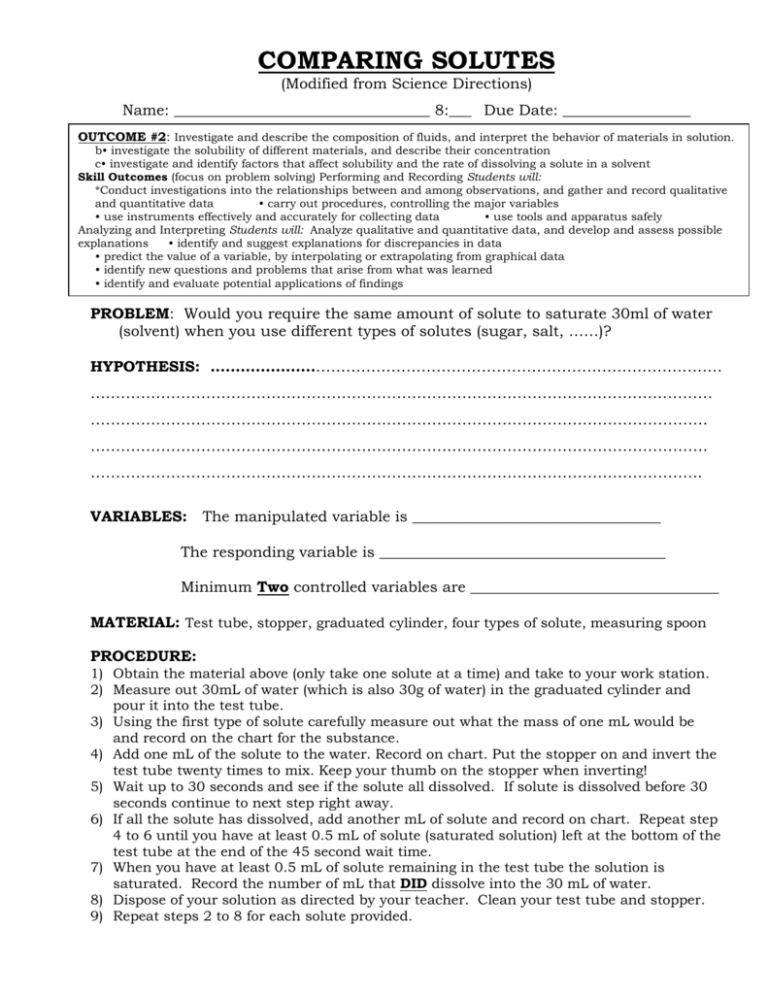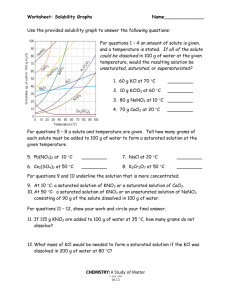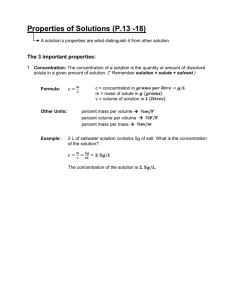COMPARING SOLUTES lab sheet
advertisement

COMPARING SOLUTES (Modified from Science Directions) Name: __________________________________ 8:___ Due Date: _________________ OUTCOME #2: Investigate and describe the composition of fluids, and interpret the behavior of materials in solution. b• investigate the solubility of different materials, and describe their concentration c• investigate and identify factors that affect solubility and the rate of dissolving a solute in a solvent Skill Outcomes (focus on problem solving) Performing and Recording Students will: *Conduct investigations into the relationships between and among observations, and gather and record qualitative and quantitative data • carry out procedures, controlling the major variables • use instruments effectively and accurately for collecting data • use tools and apparatus safely Analyzing and Interpreting Students will: Analyze qualitative and quantitative data, and develop and assess possible explanations • identify and suggest explanations for discrepancies in data • predict the value of a variable, by interpolating or extrapolating from graphical data • identify new questions and problems that arise from what was learned • identify and evaluate potential applications of findings PROBLEM: Would you require the same amount of solute to saturate 30ml of water (solvent) when you use different types of solutes (sugar, salt, ……)? HYPOTHESIS: ………………………………………………………………………………………… ……………………………………………………………………………………….…………………… …………………………………………………………………………………………………………… …………………………………………………………………………………………………………… ………………………………………………………………………………………………………….. VARIABLES: The manipulated variable is _________________________________ The responding variable is ______________________________________ Minimum Two controlled variables are _________________________________ MATERIAL: Test tube, stopper, graduated cylinder, four types of solute, measuring spoon PROCEDURE: 1) Obtain the material above (only take one solute at a time) and take to your work station. 2) Measure out 30mL of water (which is also 30g of water) in the graduated cylinder and pour it into the test tube. 3) Using the first type of solute carefully measure out what the mass of one mL would be and record on the chart for the substance. 4) Add one mL of the solute to the water. Record on chart. Put the stopper on and invert the test tube twenty times to mix. Keep your thumb on the stopper when inverting! 5) Wait up to 30 seconds and see if the solute all dissolved. If solute is dissolved before 30 seconds continue to next step right away. 6) If all the solute has dissolved, add another mL of solute and record on chart. Repeat step 4 to 6 until you have at least 0.5 mL of solute (saturated solution) left at the bottom of the test tube at the end of the 45 second wait time. 7) When you have at least 0.5 mL of solute remaining in the test tube the solution is saturated. Record the number of mL that DID dissolve into the 30 mL of water. 8) Dispose of your solution as directed by your teacher. Clean your test tube and stopper. 9) Repeat steps 2 to 8 for each solute provided. OBSERVATIONS: Type of solute mL’s added √ mL’s dissolved grams dissolved in 30g of water Class average (g/30g of water) #1: _____________ 1mL = _____grams #2: _____________ 1mL = _____grams #3: ______________ 1mL = _____grams #4: ______________ 1mL = _____grams ANALYSIS QUESTIONS: 1. Did each group come up with the same results? Explain. 2. Why should we use the class average? 3. Which of your solutions required the most amount of solute to become saturated? Convert to grams dissolved per 100g of water. Set up ratio—SHOW WORK! 4. Using the manipulated variable on the x-axis and the responding variable on the y-axis, construct a bar graph for the grams dissolved/100g of water. Attach. 5. a) Define “solubility” b) Does the type of solute affect solubility? c) Explain your answer for b) by using the particle theory. 6. For each of the statements below underline the solution that is dilute and circle the solution that is concentrated. a. Rainwater contains a small amount of dissolved carbon dioxide, but a soft drink contains much more of this gas. b. Amin mixes so much sugar with his tea that he could hardly stir it, but Rachel added only one lump of sugar to hers. c. Angela thought the fruit punch was much too sweet; the apple juice was more to her liking. 6. Which solution(s) in question 5 would you consider to be saturated? Explain. 7. Technologies based on solubility include washing your clothes with laundry detergent. Using the particle theory explain why powder detergent dissolves and does not leave white powder marks (residue) on our clothes. CONCLUSION: ………………..……………………………………………………………… ………………………………………………………………………………………………………….. …………..………………………………………………………………………………………………. ………………………..………………………………………………………………………………….. ……………………………………………………………………………………………………………… …………………………………………………………………………………………………………….. ……………………………………………………………………………………………………………… …………………………………………………………………………………………………………….. ……………………………………………………………………………………………………………… …………………………………………………………………………………………………………….. ……………………………………………………………………………………………………………… …………………………………………………………………………………………………………….. ……………………………………………………………………………………………………………… ……………………………………………………………………………………………………………… ……………………………………………………………………………………………………………… ……………………………………………………………………………………………………………… CHANGES AND/OR ERRORS: APPLICATION: Beginning Acceptable Proficient Mastery You show an incomplete understanding of the learning. Solutions are inaccurate and unworkable. You show an adequate understanding and simplistic application of the learning. Solutions contain substantial errors. Answers are partially correct. You show a solid understanding and relevant application of the learning. Solutions contain minor errors. You show an in-depth understanding and insightful application of the learning in a variety of ways. demonstrates exemplary academic achievement teacher discretion. “Solute Required to Saturated 100g of Water”






